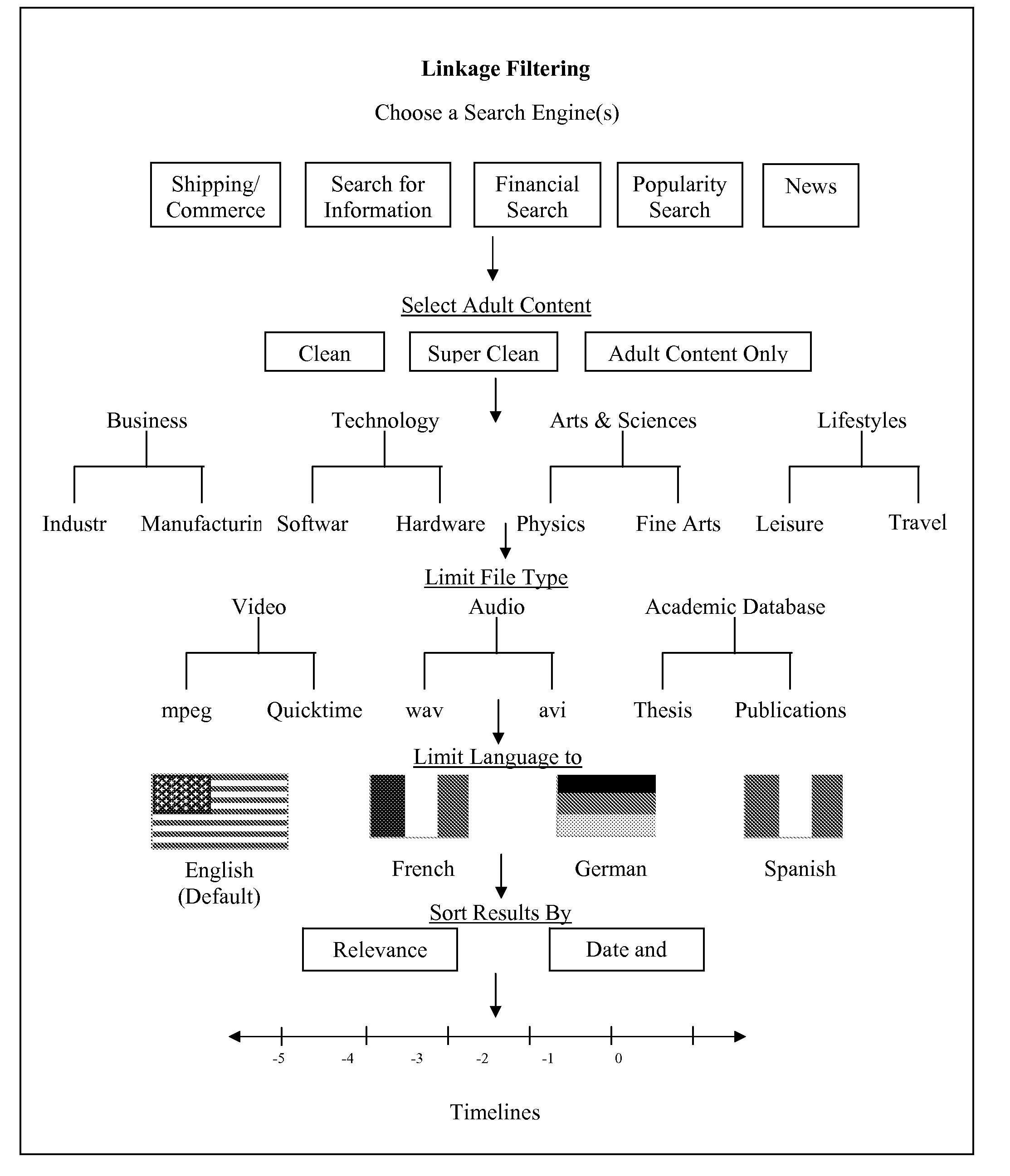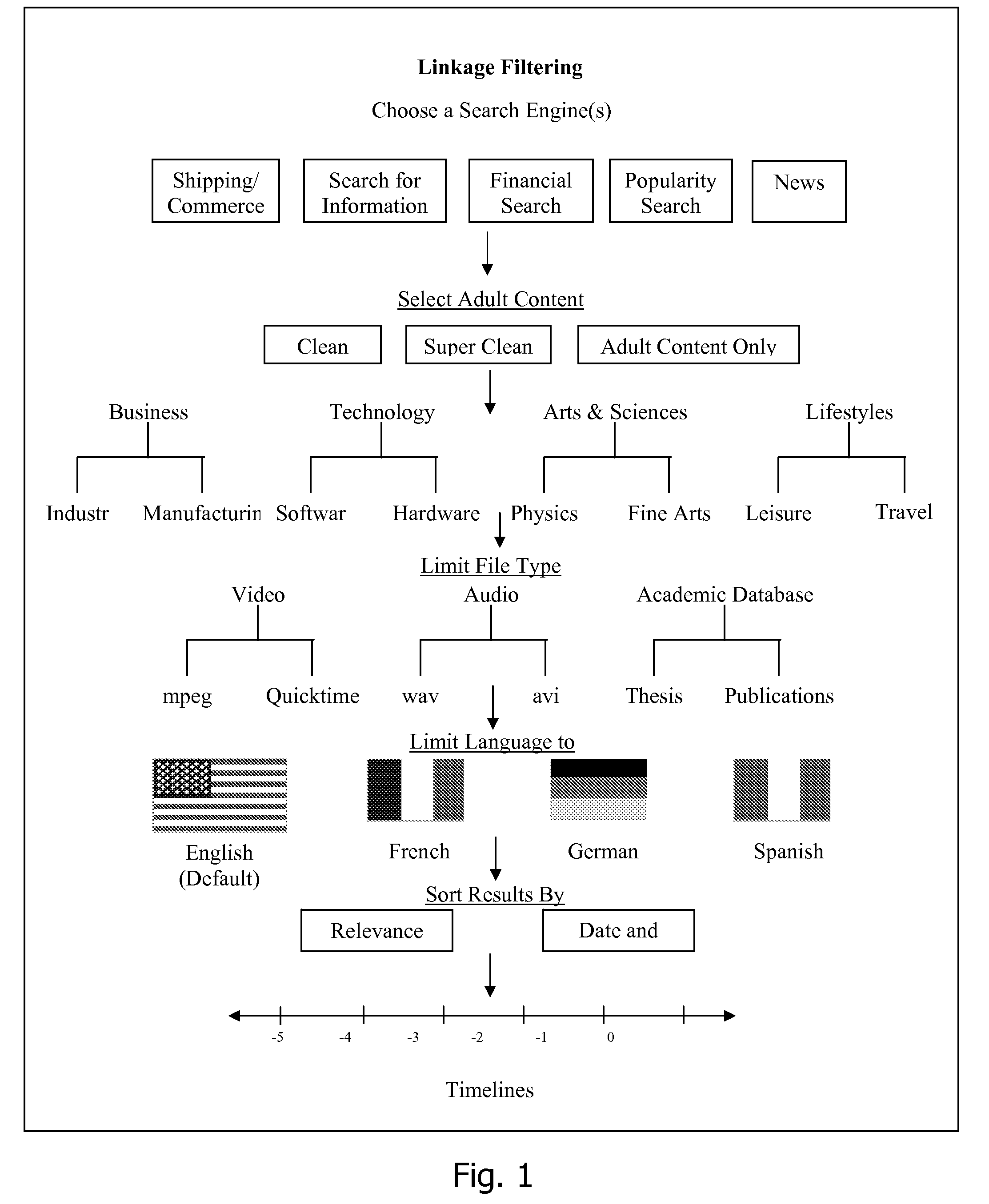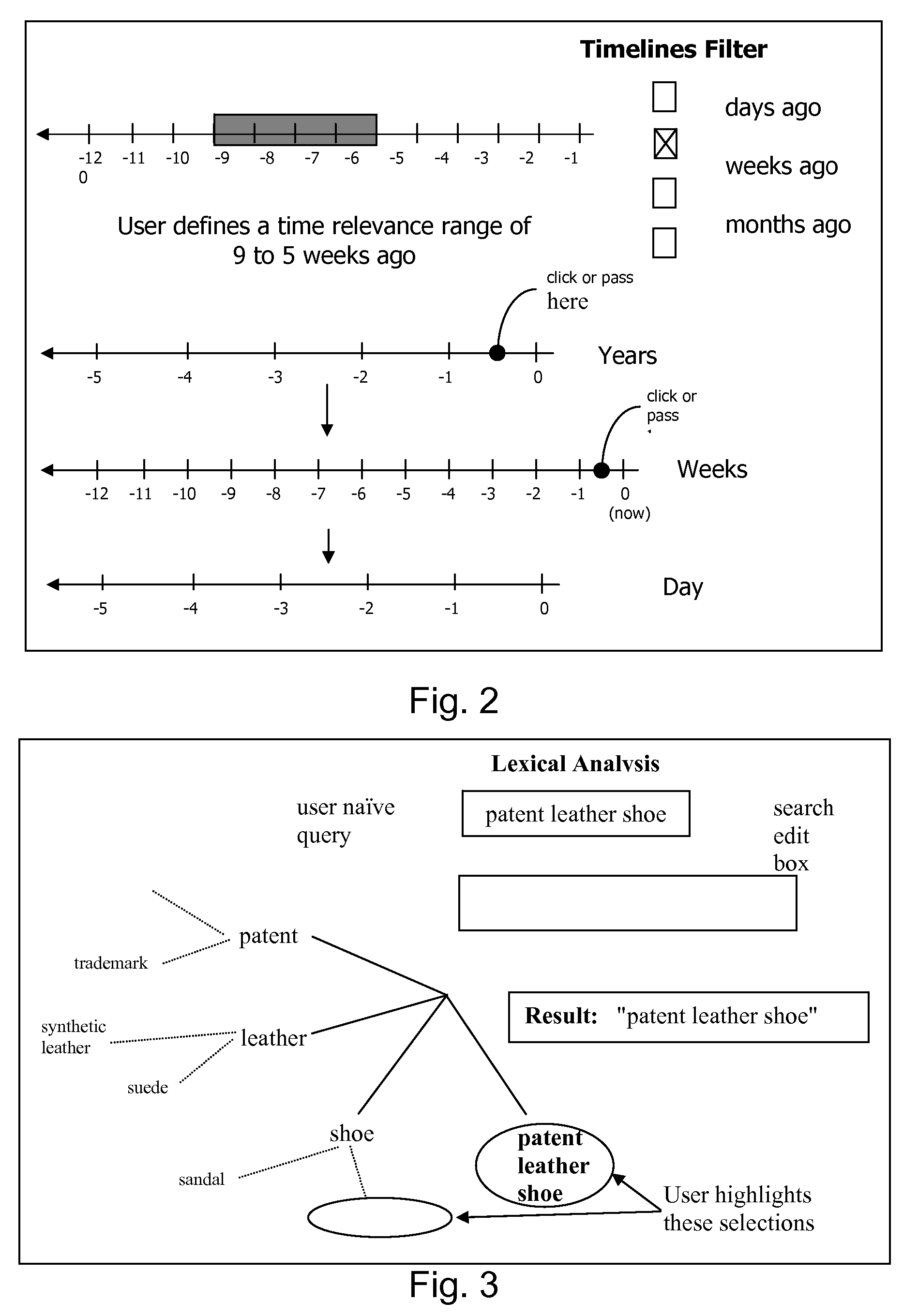However, this popularity, in conjunction with the non-standardized methods of presenting data and fantastic growth rate, have made locating desired information and navigation through the vast space difficult.
As hyperlinked
information networks become more ubiquitous, they continue to grow in complexity and magnitude, often containing hundreds of thousands of hyperlinked resources.
First, the information content of some resources may change over time, so that following the same link at different times may lead to a resource with slightly different, or entirely different information.
Second, the very structure of the networked information resources may change over time, the typical change being the addition of documents and links.
However, this type of structure often requires some familiarity with the classification
system, to avoid
elimination of relevant resources by improperly limiting the search to a particular classification or group of classifications.
However, the retrieval process is often time-consuming and cumbersome.
Recently, the number and variety of Internet web pages have continued to grow at a
high rate, resulting in a potentially large number of records that meet any reasonably broad or important search criteria.
Likewise, even with this large number of records available, it can be difficult to locate certain types of information for which records do in fact exist, because of the limits of
natural language parsers or Boolean text searches, as well as the generic
ranking algorithms employed.
The proliferation of resources on the Web presents a major challenge to search engines, all of which employ proprietary tools to sift the enormous document load to find materials and sites relevant to a user's needs.
A well-recognized problem with existing search engines is the tendency to return hits for a query that are so incredibly numerous, sometimes in the hundreds, thousands, or even millions, that it is impractical for user to wade through them and find relevant results.
Many users, probably the majority, would say that the existing technology returns far too much “garbage” in relation to pertinent results.
However, despite the apparent sophistication of many of the relevance testing techniques employed, the results typically fall short of the promise.
However, this principle has not operated very extensively in the
search engine marketplace, partly because there is little differentiation among the known characteristics of the users of particular search engines, and because, even after a search inquiry in submitted, there may be little basis on which to judge what user's intention or interest really is, owing to the generality or
ambiguity of user's request, so that even after a search request is processed, it may be impossible to estimate the salient economic, demographic,
purchasing or interest characteristics of the user in the context of a particular search.
Thus, the existing techniques tend to exaggerate short term, ignorance based or antithetical interests of the user, since these represent the available
data set.
Clearly, the simple presumptions that are behind this parade of horribles may often result in erroneous conclusions.
Another inherent problem with the present technology of search engines is that the user, to make a
request for information, must use words from
natural language, and such words are inherently ambiguous.
Because the technology of existing search engines cannot generally distinguish various users intentions, typically such engines will return results for all possible meanings, resulting in many irrelevant or even ludicrous or offensive results.
Yet another problem with existing
search engine technologies relates to the problem of organizing results of a search for future use.
Internet browsers, which are presently complex
software applications that remain operative during the course of a search, can be used to store a particular URL for future use, but the lists of URLs created in this way tend to become very long and are difficult to organize.
Therefore, if a user cannot remember a pertinent URL (many of which are long or obscure), the user may be forced to go search again for resources that user might wish were ready at hand for another use.
Although a few search engines for the
mass market exist that charge a fee for use, this model has not been popular or successful.
When a user has an interest in a topic, he may not know what resources can be assembled for a search, nor the location of the resources.
One existing problem in the prior art is that the scores for each document are not absolute, but dependent on the statistics of each collection and on the algorithms associated with the search engines.
A second existing problem is that the standard prior art procedure requires two passes.
A third problem that exists is that the prior art requires that all collections use the same type
search engine, or at least a bridge component to translate into a common format.
However, many existing searching / retrieval systems are not adapted to identify the best or most
relevant information yielded by the query search.
This process is very
time consuming and expensive, as there is often a large number of incoming documents to be processed.
The subjecting process may be further complicated if certain documents should properly be categorized in more than one subject.
Automated systems for categorizing documents have been developed, for example based on semantic structures; however, these may be of variable quality or make erroneous conclusions.
A known problem in providing access to multiple databases is the relative difficulty or inefficiency in identifying an optimal
database or set of databases that should be searched to obtain the best search report for some particular unstructured, or ad hoc,
database query.
Consequently, the selection of a most appropriate set of databases to search may place a substantial burden on the user for each query.
Such a database set selection is difficult since the selection is made preemptively and independent of the query.
This burden may be even more of an issue where access fees are charged for conducting a search against a database even where no search responsive documents are found or examined.
In the aggregate, this problem is typically referred to as the “collection selection problem.” The collection selection problem is complicated further when the opportunity and desire exists to search any combination of public and private document collections.
The collection selection problem is formidable even when dealing with a single collection provider.
With over 50,000 major databases estimated presently available on
the Internet, the collection selection problem is therefore impractical to solve reliably and efficiently by a user.
The performance of such automatons, however, is often imperfect, if not simply incorrect, in their assessments of
client databases.
Even at best, certain
client databases, including typically private and proprietary document collections, may block access by the automatons and are thus completely unrepresented in the master database.
Even where
database access can be obtained and document summaries automatically generated, the scaling of the master database becomes problematic if only due to the incomplete, summary, and mischaracterization of
document summary entries in the master database.
Manual intervention to prepare and improve
automaton generated document summaries may enhance the usefulness of the master database, but at great cost.
When any manual intervention is required, however, the scaling of the master database comes at least at the expense of the useful content of the master database
document summary entries.
Unfortunately, even at only a modest scale, a master database of manually generated or modified document summaries becomes an impracticable construct to build or maintain.
The GLOSS
system is therefore highly subject to failures to identify
client databases that may contain only a relatively few instances of the query terms, yet may contain relevant documents.
The known implementations of
inference networks are unable to accurately rank the potential relevance of client databases of diverse size and differences in the generation of summaries for each of the client databases considered.
Thus, the known approaches to solving the client database collection selection problem are generally viewed as inefficient in the
assembly, construction, and maintenance of a master document database.
These known systems are also viewed as often ineffective in identifying the likely most relevant documents within entire sets of collections because real world collections are often highly variable in size, scope, and content or cannot be uniformly characterized by existing quantitative approaches.
Another and perhaps practically most significant limitation of these known systems is that each must be self-contained in order to operate.
For example, hardware and maintenance costs are involved in establishing and maintaining information servers and networks.
As the amount of information available to a computer user increases, the problem of coherently presenting the range of available information to the computer user in a manner which allows the user to comprehend the overall scope of the available information becomes more significant.
The main problem associated with the use of lists is the difficulty of indicating the size and complexity of the database containing the available information.
Furthermore, because presentation of the lists normally requires a significant part of the screen, the user is forced to reduce the amount of screen occupied by the
list when textual and visual information contained in the database is sought to be viewed.
When this occurs, the user's current “position” relative to other data units of the available information is lost.
Although semantic networks may be useful for finding additional relevant documents responsive to a query, this technique also tends to increase the number of irrelevant documents located by the search, unless other techniques are also used.
This approach is difficult to apply to large, dynamic hyperlinked
information networks that may be too large to search exhaustively.
Furthermore, the dynamic nature of such networks requires repetitively searching and updating the
hyperlink index.
This task involves continually accessing various network
server locations, which requires a significant amount of network bandwidth, computing resources, and time.
Frequently, however, users may be able to easily recognize a document meeting their information need, but may have difficulty expressing that need explicitly in a format appropriate for the
information retrieval system.
Furthermore, rather than inundating the user with information selected from a general, broad query, the amount of information presented to the user is limited so as to minimize the time and effort required to review the information.
Furthermore, multiple identifications of a document, both on the basis of single word and
phrase index identifications, results in a desirable bias of the search report
score towards most relevant documents.
As alluded to above, however, building a transaction database is only part of the marketing challenge.
Such database mining becomes increasingly problematic as the size of databases expands into the
gigabyte, and indeed the terabyte, range.
However, association rules have been limited in scope, in the sense that the conditions precedent and subsequent fall within the same column or field of the database.
While the above program may induce customer loyalty, it has the
disadvantage that the selection of prizes can be made only from the limited
list of awards provided by the company.
However, while such programs may enhance the selection of prizes, there is still the problem of obtaining the credit instrument for redeeming the awarded points.
Thus, the immediacy effect of the reward is lacking in these conventional incentive programs.
As can be expected, these
heuristics are often complex and difficult to implement without losing substantive information from the index.
Furthermore, as these
heuristics generally operate on a collection-wide basis to minimize unbalanced loss of information, a
distributed database architecture for storing the document collection variously becomes prohibitively complex to implement, slow in terms of query
response time and quite limited in providing global relevancy
ranking.
Thus, existing search systems cannot effectively operate against a document collection index that, due perhaps to size or to support parallel access, is fragmented over multiple
server systems or against multiple collection indexes that are served from multiple
distributed servers.
Consequently, the convenience, as well as capacity and performance, potentially realized by use of
distributed servers is not generally realized in the implementation of conventional search systems.
Another significant limitation of conventional search systems relates to the need to ensure the timeliness of the information maintained in the collection indexes.
The process of building and rebuilding a collection index is quite
time consuming.
Known index preparation functions and procedures are unfortunately one, if not many orders of magnitude slower than the typical rate of document collection content change.
Thus, practical considerations have generally become limiting factors on the performance, size and assured timeliness in searching collections for query identified documents.
 Login to View More
Login to View More  Login to View More
Login to View More 


